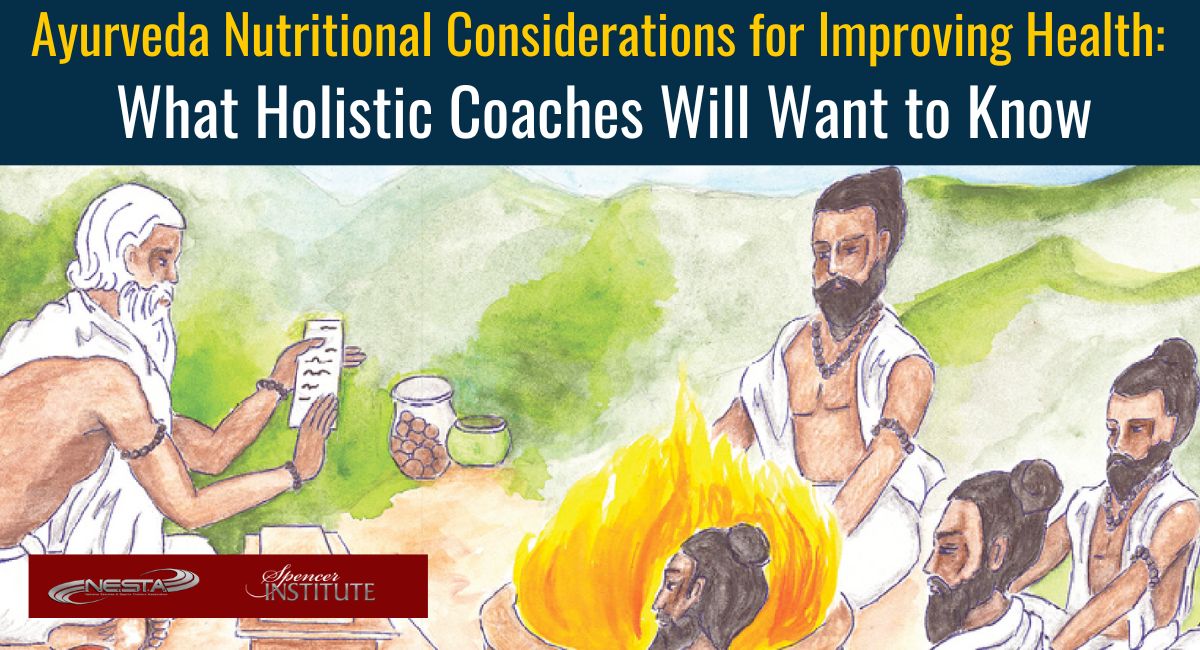\ What do you do if you are bored with your current food choices or eating healthy? What if your intuition tells you that our client will be receptive to Ayurveda and thus benefit from incorporating its principles into their holistic lifestyle? Maybe they have outwardly stated that they are ready for a change.
What do you do if you are bored with your current food choices or eating healthy? What if your intuition tells you that our client will be receptive to Ayurveda and thus benefit from incorporating its principles into their holistic lifestyle? Maybe they have outwardly stated that they are ready for a change.
Ayurveda could also be seen as a way to enhance or augment physical holism, perhaps more so than having our client eat organics. This because Ayurveda is a complete way of restoring the body’s balance.
Ayurveda, translated as the “science of life,” is an that utilizes various therapies including diet, yoga, and herbal preparations to restore harmony and balance within the body. But one does not simply proclaim themselves an Ayuerveda practitioner until they have been formally trained in a professional manner. If this is not something you are interested in, it does not mean that your client can not benefit from learning some Ayurveda principles.
Both Holistic Life Coaches , Holistic Nutrition Coaches and Lifestyle and Weight Management Coaches can consider Ayurveda for their clients.
The principles of Ayurveda are based on the concept of tridosha, or the system of three doshas. The three doshas, known as Vata, Pitta and Kapha, are dynamic forces with distinct characteristics that shape all things in the universe. Each person is born with a unique constitution, called prakriti, which is composed of varying amounts of influence from each of the three doshas.
In the Ayurvedic view, an imbalance between the doshas produces a condition called vikriti, a Sanskrit word that means “deviated from nature.” According to Ayurvedic principles, each individual’s diet should be suited to his or her prakriti.
During times of vikriti, or imbalance, the diet can be used to either decrease or increase the three doshas until balance is restored. The dosha balancing effect of a food is determined by its taste, either salty, sour, sweet, bitter, astringent, or pungent and its other qualities, either heavy, oily, cold, hot, light, or dry.
History
Ayurveda is one of the most ancient systems of medicine in the world, with its roots reaching back to the 9th century BC. Hindu legend holds that Lord Brahma, the god of creation, upon recognizing the intense suffering of human civilization, taught various spiritual leaders ways to ease this suffering.
For thousands of years, these teachings were transmitted orally, but were eventually recorded during the Vedic period of ancient India as Sanskrit poetry and compiled into the classic books known as the Four Vedas.
One of these texts, named the Rik Veda, contains verses on the nature of health and disease and discusses the concept of the three doshas (Vata, Pitta, and Kapha). Another text, called the Atharva Veda, lists the eight divisions of Ayurveda: Internal Medicine, Surgery of Head and Neck, Ophthalmology and Otorhinolaryngology, Surgery, Toxicology, Psychiatry, Pediatrics, Gerontology or Science of Rejuvenation, and the Science of Fertility.
Later writers, including Sushruta and Charaka, took passages from the Vedic Scriptures and compiled them into separate medical textbooks, called Samhitas. The Sushruta Samhita, one of the most widely accepted Ayurvedic texts, outlines surgical techniques. The Charaka Samhita is a major text on internal medicine. Due to its long history and its influence on the development of Chinese, Arabic, Greek, and Roman medical thought, Ayurveda is often referred to as the “mother of medicine.”
Popularity
Ayurveda is the primary system of medicine in India, and is practiced by many people in the countries surrounding India. Ayurvedic priniciples, including Ayurvedic diet recommendations, are gaining popularity throughout the Western world as many people seek health care options that are more holistic and wellness-oriented.
Principles
In humans, the doshas control all mental, emotional, and physical functions and responses, and also determine the state of the soul. They produce natural urges and individual preferences in food. They govern the maintenance and destruction of bodily tissue and the elimination of waste products.
As mentioned, each person is born with a unique prakriti (Sanskrit for “essential nature”), a constitution or personal blueprint composed of varying amounts of influence from each of the three doshas. Each person’s prakiti describes the unique harmony or balance between the doshas that is necessary for that person to experience perfect health.
Also part of the Ayurvedic view, Vikriti results from an over-expression of one or two doshas (usually the dominant dosha) and a diminished expression of the other dosha. This imbalance can be caused by eating the wrong foods, chronic mental stress, physical overexertion, negative emotions, or poor sleeping habits, and will eventually lead to the development of disease, obesity and/or mental disorders. As a result, to prevent disease, each individual must maintain the doshas in, or restore them to, their proper balance.
Only a small percentage of people are purely Vata, Pitta, or Kapha. Each of us possesses a proportion of all three doshas. In many cases, two doshas combine to determine our dominant physiological and personality traits.
Vata, translated as “wind”, has the elements of ether and air, and controls all movement in the body, including the flow of blood to and from the heart, the expansion and contraction of lungs that makes breathing possible, and the contractions that push food through the digestive tract.
The person with a Vata prikiti is typically of slight, thin build, and demonstrates great enthusiasm, imagination, and vivaciousness. Vata types grasp new concepts quickly, but forget things easily. They have bursts of mental and physical energy, love excitement and constant change, and display dramatic mood swings. Vatas tend to have irregular eating and sleeping patterns.
When out of balance, Vata types experience dry or rough skin, constipation, tension headaches, cold hands and feet, anxiety and worry, fatigue, poor and irregular appetite, insomnia, arthritis, and difficulty maintaining their ideal body weight. The Vata constitution is characterized by swift change, and, as a result, it goes out of balance more easily than the other doshas.
Pitta, related to fire, controls metabolism and digestion and regulates appetite. Pitta types are often of medium build and medium strength and typically have blond, red, or light brown hair with freckled or ruddy skin. The basic theme of the pitta constitution is intensity.
Pitta types are ambitious, self-disciplined, enterprising, articulate, intelligent, and outspoken. When in balance, they are warm and loving; out of balance, they can be demanding, sarcastic, critical, argumentative, or jealous. Unlike Vata types, Pittas experience intense hunger and cannot skip meals.
When out of balance, Pitta types experience rashes, inflammatory skin diseases, heartburn, peptic ulcers, visual problems, irritability, premature graying or baldness, and tend towards compulsive behavior (e.g. alcoholism, eating disorders, etc.).
Kapha, derives from water and earth, and controls the structures of the body, giving strength and physical form to cells and tissues. Kapha types are of solid, powerful build and display great physical strength and endurance. A primary characteristic of the kapha prikiti is contentment.
Kaphas are relaxed, affectionate, serene, slow to anger, forgiving, happy with the status quo, and respectful of the feelings of others. They tend to require lots of sleep, have slow digestion, and moderate hunger, though they find comfort in eating.
Kaphas typically enjoy good health, but tend to become obese more often than Vata or Pitta types. When out of balance, Kapha types may experience colds and flu, allergies, sinus congestion, depression, lethargy, asthma, and joint problems.
In Ayurveda, diet is one of the key ways to maintain and restore dosha balance. According to Ayurvedic principles, each individual’s diet should be suited to his or her prakriti. And, during times of vikriti, or imbalance, the diet can be used to either decrease or increase the three doshas until balance is restored. The dosha balancing effect is determined by its taste and qualities.
In Ayurvedic nutrition there are six different tastes and six major qualities. The tastes and qualities with attributes similar to those of a dosha increase that dosha, while tastes and qualities dissimilar to the characteristics of a dosha decrease that dosha. The six tastes and the six major food qualities, and their effect on the different doshas are listed below:
The Six Tastes
- Bitter: The bitter taste is found in spinach, romaine lettuce, endive, chicory, chard, kale, and tonic The bitter taste decreases both kapha and pitta, but increases vata.
- Pungent: The pungent taste is found in chili peppers, cayenne, ginger, and other hot-tasting spices. The pungent taste decreases kapha, but increases pitta and
- Astringent: The astringent taste is found in beans, lentils, cabbage, apples and The astringent taste decreases kapha and pitta, but increases vata.
- Salty: The salty taste is found in any food to which salt has been added. The salty taste increases kapha and pitta, but decreases
- Sour: The sour taste is found in lemons, limes, vinegar, yogurt, cheese, and plums. The sour taste increases kapha and pitta, but decreases vata.
- Sweet: The sweet taste is found in table sugar, honey, rice, pasta, milk, cream, butter, wheat and The sweet taste increases kapha, but decreases pitta and vata.
The Six Major Food Qualities
- Heavy: Heavy foods include bread, pasta, cheese, and The heavy quality decreases vata and pitta, but increases kapha.
- Light: Light foods include millet, buckwheat, rye, barley, corn, spinach,
- lettuce, pears and The light quality decreases kapha, but increases vata and pitta.
- Oily: Oily foods include dairy products, meat, fatty foods, and cooking oils. The oily quality decreases vata and pitta, but increases
- Dry: Dry foods include beans, potatoes, barley, and corn. The dry quality decreases kapha, but increases vata and pitta.
- Hot: The hot quality describes hot beverages and warm, cooked foods. The hot quality decreases vata and kapha, but increases
- Cold: The cold quality describes cold beverages and raw The cold quality decreases pitta, but increases kapha and vata.
By selecting foods appropriate for your prakriti, you can maintain or restore your proper dosha balance. Here are a few dietary and lifestyle suggestions for balancing the different doshes.
To balance Vata:
Because the Vata constitution is characterized by swift change and is easily thrown out of balance, Vata types benefit from sticking to a daily routine with consistent meal times and a regular sleeping pattern. Vatas should eat plenty of heavy, hearty foods, such as stews, breads and warm desserts, and should drink lots of warm fluids (e.g. herbal tea). On the other hand, raw fruits and vegetables and cold beverages should comprise only a small part of a Vata-balancing diet.
To balance Pitta:
When out of balance, Pitta types tend to work excessively. As a result, it is important for Pittas to avoid overscheduling and to balance work and other commitments with sufficient recreation and leisure. Pittas should avoid skipping meals, and should avoid overeating at meals.
Pitta types are well-suited to a vegetarian diet, and benefit tremendously from consumption of fruits, raw vegetables and cold beverages. Pittas may also eat starchy vegetables, grains and beans, but should eliminate spicy and overcooked foods.
To balance Kapha:
Because Kapha types tend to gain weight easily and have difficulty shedding unwanted pounds, regular exercise is crucial for weight management. In addition, Kapha types should eat only when hungry and should consider doing a 24-hour liquid fast as often as one time per week.
Kapha types should avoid ice cream, butter, milk, rich and sugary desserts, meat, and fried foods. Instead, Kaphas should consume large amounts of raw vegetables, fruits and beans, and may improve their digestion by drinking hot ginger tea.
Regardless of your dominant dosha, Ayurvedic nutrition principles encourage the consumption of fresh, unprocessed foods. Ayurvedic principles also govern the timing of meals. In the Ayurvedic view, one of the doshas is dominant at all times during the day, a theory called The Master Cycles of Vata, Pitta, and Kapha.
In the first cycle, Kapha predominates from 6 am to 10 am, Pitta predominates from 10 am to 2 pm, and Vata predominates from 2 pm to 6 pm. In the second cycle, Kapha predominates from 6 pm to 10 pm, Pitta predominates from 10 pm to 2 am, and Vata predominates from 2 am to 6 am.
Because the Pitta dosha is responsible for digestion and metabolism, the ideal time for a large meal is during the period from 10 am to 2 pm when Pitta is dominant. As a result, all people, regardless of their dominant dosha, should take their largest meal sometime around 12 noon.
Research
Although the principles of Ayurvedic medicine have been used successfully to prevent and treat disease for thousands of years in India, many medical experts do not consider traditional use as evidence of efficacy, relying instead on the results of well-designed clinical trials.
While a significant amount of scientific research documents the efficacy of various Ayurvedic herbal preparations for the treatment of a small number of specific medical conditions, the scientific community is just beginning to formally evaluate the benefits of the Ayurveda system of medicine in the prevention and treatment of chronic diseases.
In the year 2000, a small case study involving 4 patients, one with sarcoidosis, one with Parkinson’s disease, a third with renal hypertension, and a fourth with diabetes/essential hypertension/ anxiety disorder, was conducted. The four patients, who were given Ayruvedic treatments for three weeks, experienced a reduction in the major signs and symptoms of their condition.
Foods Emphasized
The Ayurvedic diet recommends foods for each dosha based on the taste and quality of food.
Vatas should emphasize the consumption of foods with a salty, sour or sweet taste. Vatas should also eat plenty of foods that are heavy, oily, and hot in quality. More specifically, Vatas do well on a meat- based diet, and can handle lots of dairy products in the diet. In addition, Vatas should eat only well- cooked foods and consume warm beverages instead of cold beverages.
Pittas should emphasize the consumption of foods with a bitter, sweet, or astringent taste. Pittas are also encouraged to consume foods that are heavy, oily and cold in quality. Pittas are well-suited to a vegetarian diet.
Kaphas should emphasize the consumption of foods with a bitter, pungent, or astringent taste. Kaphas need lots of foods that are light, dry, and warm in quality. More specifically, all vegetables are suitable for Kaphas, and because Kaphas tend to have slow digestion, ginger should be eaten every day for its ability to stimulate digestion. Although Kaphas can handle some meat in the diet, it should be eaten on an occasional basis only.
Foods Avoided
Vatas should avoid foods with bitter, pungent or astringent tastes. Vatas should also avoid foods that are light, dry, or cold in quality.
Pittas should avoid foods with pungent, salty, or sour tastes. Pittas should also avoid foods that are light, dry, or hot in quality.
Kaphas should avoid foods with salty, sour, or sweet tastes. Kaphas should also avoid foods that are heavy, oily, or cold in quality.
Nutrient Excesses/Deficiencies
Following Ayurvedic diet principles does not limit the quantity or variety of food that can be eaten. As a result, such a diet is not likely to be deficient in any nutrients, assuming the person is eating enough calories and selecting a wide variety of foods.
It is also highly advisable to avoid the following:
- Refined sugar/flour/rice.
- Hydrogenated fats (margarine)
- Junk foods, fizzy sodas, additives and other highly processed foods
- Pork products, high in nitrates
- Shellfish, has concentrated toxins in their tissues
Toxic Mold & Yeast in the Diet
Some type of mold or yeast fungus disease affects an estimated 50% of people seen as patients, and can cause as many diseases as bacteria and viruses.
This affects digestion and the absorption of essential vitamins and minerals. Over time, the result is chronic progressive disease such as cardiovascular ailments, arthritis, gout, asthma, allergies, sinusitis, gastritis, tuberculosis, cancer, and more. The most common symptoms include sneezing, wheezing, joint pain, muscle aches, headaches, fatigue, depression, anxiety, irritability, confusion, rashes, itching, poor memory, numbness, digestive ailments, abdominal pain, bloating, gas, constipation hives, rashes, vaginal yeast infections, and urinary frequency, attacks of anxiety and shaking when hungry, and the symptoms can also be flu-like. Mold can cause fungal diseases of the skin, nails, ears and lungs.
Your client may experience a few of these symptoms or, actually, many are possible if related to a mold or yeast infection. (Candidiasis). This can be caused by a poor diet (high in sugar and carbohydrates) and high stress levels, which keep feeding the yeast overgrowth. Mold can grow on bread or cheese, overripe fruit, vegetables, grains, and other foods and get food by absorbingwater or from decaying matter on which they live.
Candida albicans is an harmless yeast that naturally lives in every one’s gastrointestinal tract, mucous membranes and on the skin. It lives there in a symbiotic world in a healthy person’s
body but when your body’s eco-system becomes unbalanced, Candida overgrowth can occur, thus allowing it to attack any organ or system in your body, primarily targeting the nerves and muscles, but can attack any body tissue or organ depending on your body’s predisposition.
Dietary changes can help reduce yeast as well as can a number of herbs and supplements and can promote a healthy digestive tract. Studies have shown that herbs such as garlic, barberry, oregano, Oregon grape and goldenseal, as well as the fatty acid caprylic acid, can inhibit the growth of yeast.
In case there is evidence of mold allergy, a four- day rotation diet is recommended to minimize contact with allergens. This is a diet where foods are eaten once every four days. Foods that may contain mold are peanuts, beef, tomatoes, citrus fruits, chocolate, soy, MSG, sulfites and aspartame (Nutrasweet/Equal).
This diet restricts foods that contain yeast and gluten, brown rice, popcorn, corn products, honey, smoked, dried, pickled and cured foods such as buttermilk and sour cream, (live cultured yogurt helps to replenish your bacterial intestinal bacteria), no aged cheese of any kind – (some cheeses are okay if milk is not a problem, e.g. cottage cheese, mozzarella, provolone, ricotta and farmer’s cheese).
- Avoid eggs, beef, corn, and potatoes, mushrooms, nuts or nut butter (except almonds and almond butter), fruit juices, (frozen fruit juice is fine), dried or candied fruit and coffee, black tea, caffeine, cider and homemade root beer (commercial root beer is fine).
- No canned tomatoes, unless homemade. Avoid citric acid, which is a very common food additive; not derived from citrus fruit).
- Eat leftovers within 24 hours. Multi-B Vitamins
- Organic foods, although much better for the body (affected by toxic mold due to the lack of chemicals) tend to mold more quickly as they lack artificial preservatives.
- Drink bottled Tap water contains mold. Try to drink distilled or reverse osmosis water as it retains the good bacteria in the digestive tract.
- To fight Candida it is best to reduce all foods high in carbohydrate; sugars and starches in order to starve the Candida yeast. Wheat does not directly feed yeast but since it is a common food sensitivity it is a good idea to eliminate it in the
The Causes of Candida Overgrowth can be antibiotics, steroids such as cortisone, prednisone, birth-control pills, and estrogen replacement therapy, poor diet, chemotherapy, radiation, stress, and alcohol over-use. Avoid all chemical foods and drugs. Strong antibiotics, steroids, corticosteroids and tobacco must be avoided. This diet is necessary for the first critical weeks. This is the only way to deprive the yeast of nutrients and kill it off. Symptoms are often worsening in damp and/or moldy places.
The Candida cleansing diet should include the following foods, in the correct proportions; 65% high fiber, low starch vegetables such as broccoli, celery, radish and asparagus. Consume plenty of fresh steamed vegetables, especially onions, garlic, ginger root, cabbage, carrots, peas, sweet potato, cauliflower and yams. Onions and garlic are very good anti-fungals. All root vegetables should be peeled.
- The 20% Group – foods that are high protein
- such as antibiotic-free fish, fowl, nuts, seeds and Note: spray all nuts and seeds with a solution of 15-30 drops GSE (grapeseed extract) in 2-cups water to kill any aflatoxins mold or fungus that may be present. All nuts should be roasted.
- 10% complex carbohydrates such as brown rice, beans, millet, amaranth, quinoa and
- 5% fruit; papaya pineapple, grapefruit, peaches, pears, and all types of berries.
- Other acceptable foods are seafood and sea vegetables, olive oil, eggs mayonnaise, white rice, soy and vegetable pastas, white rice cakes and crackers, some citrus fruit, herb teas and unsweetened cranberry juice.
This type of diet also reduces the unpleasant effects of headaches, nausea and fatigue, known as the “herxhiemer reaction,” which are caused by the release of toxins when pathogenic microbes “die-off.”
Spencer Institute and NESTA have been helping new and experienced coaches and trainers since 1992. We are here to help you, too. Let us know how we can serve you.










